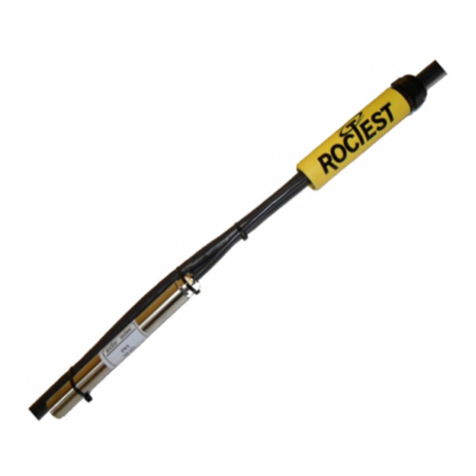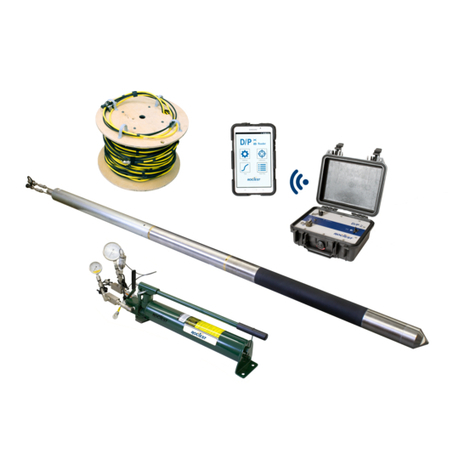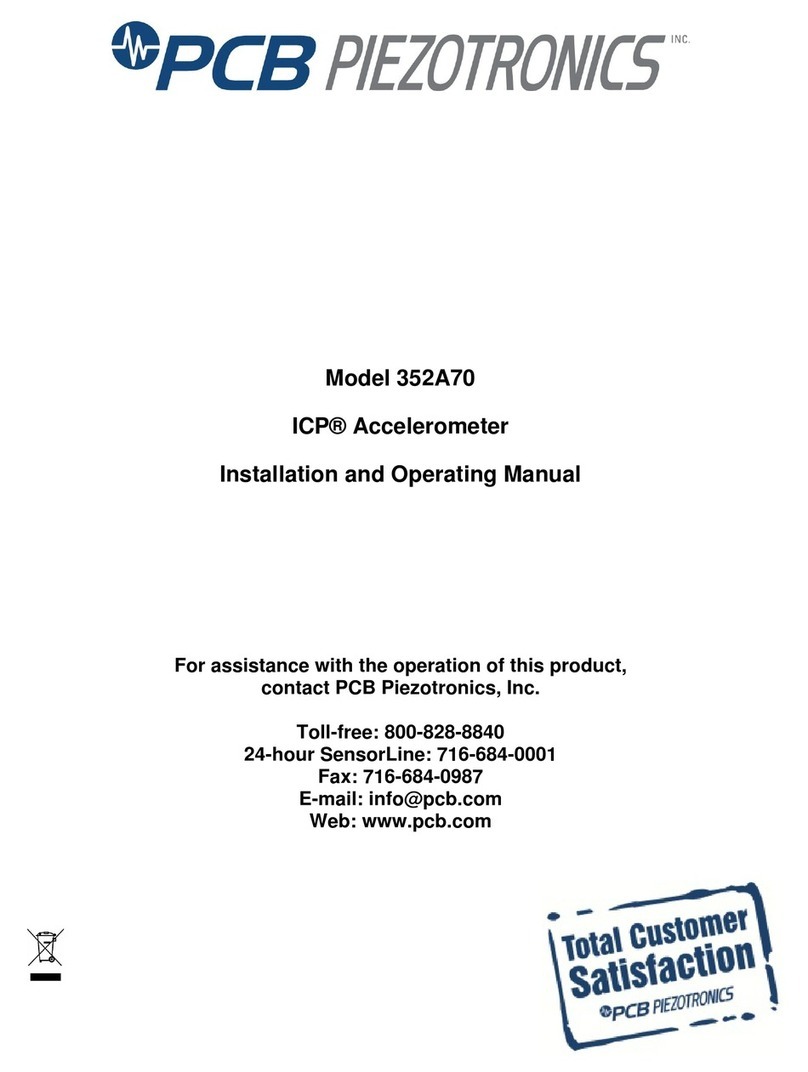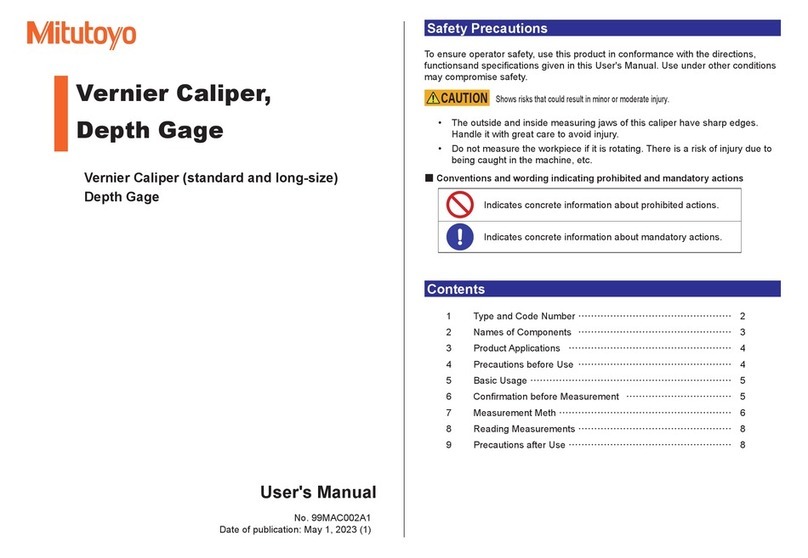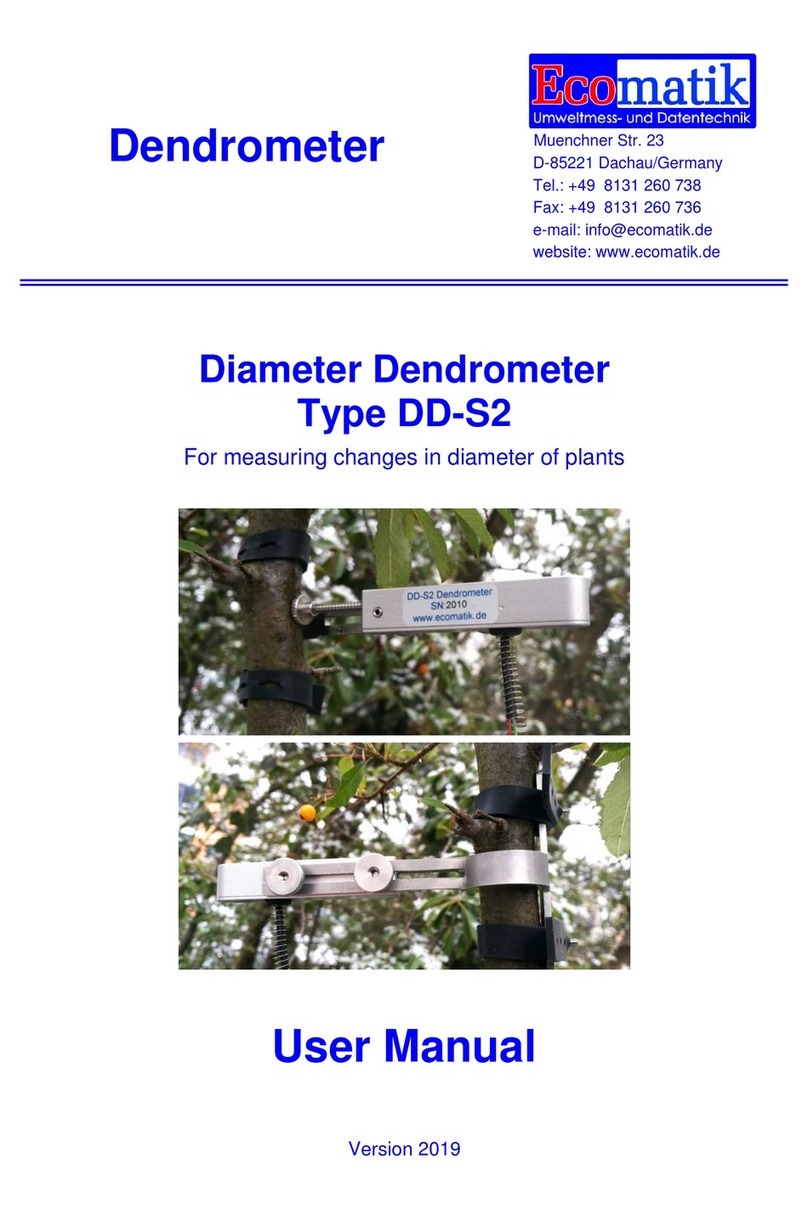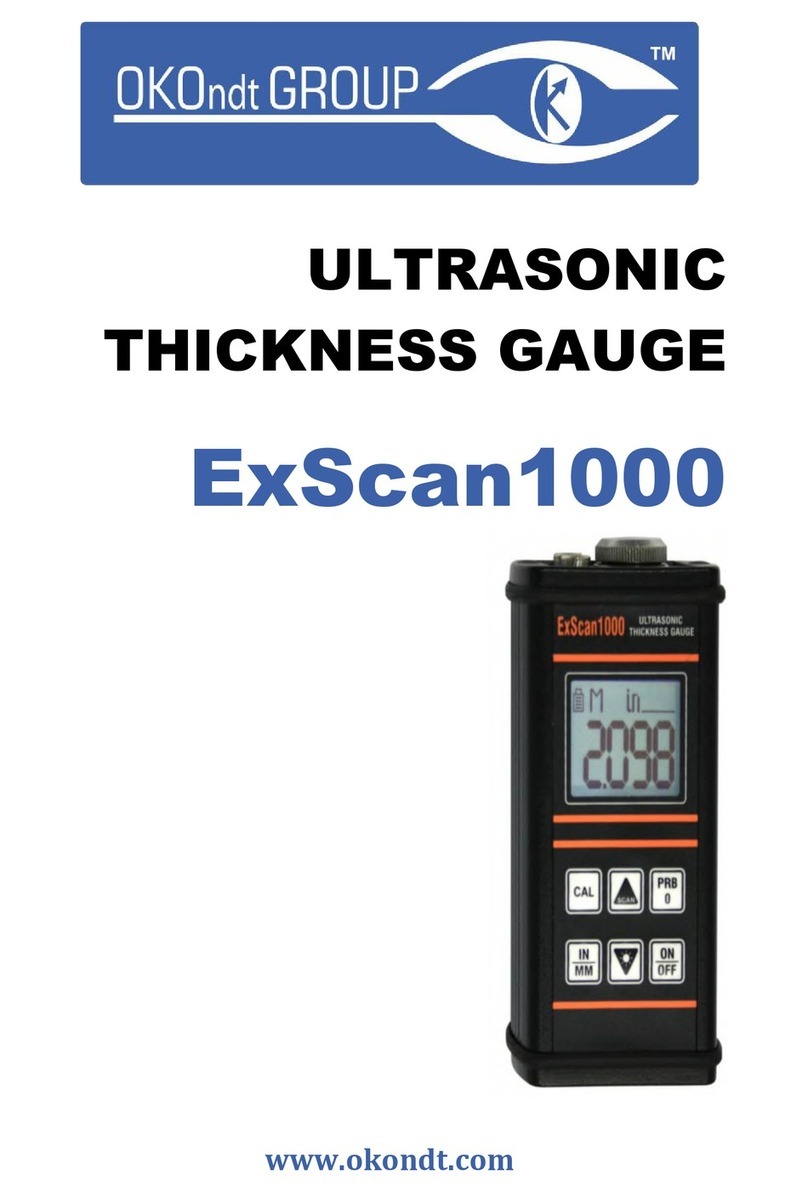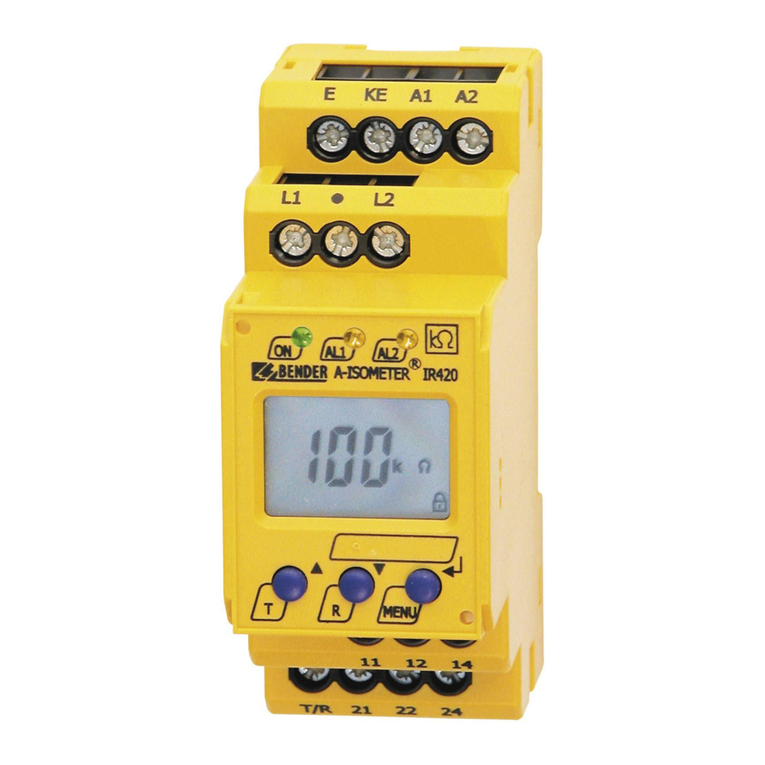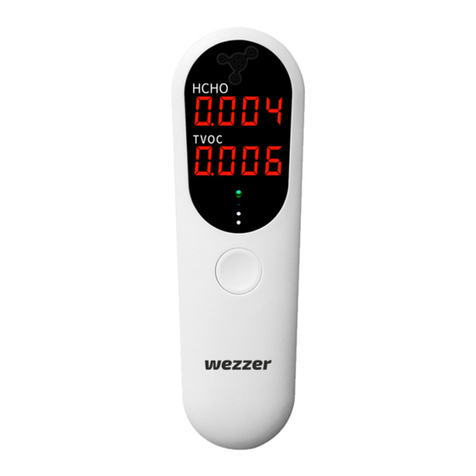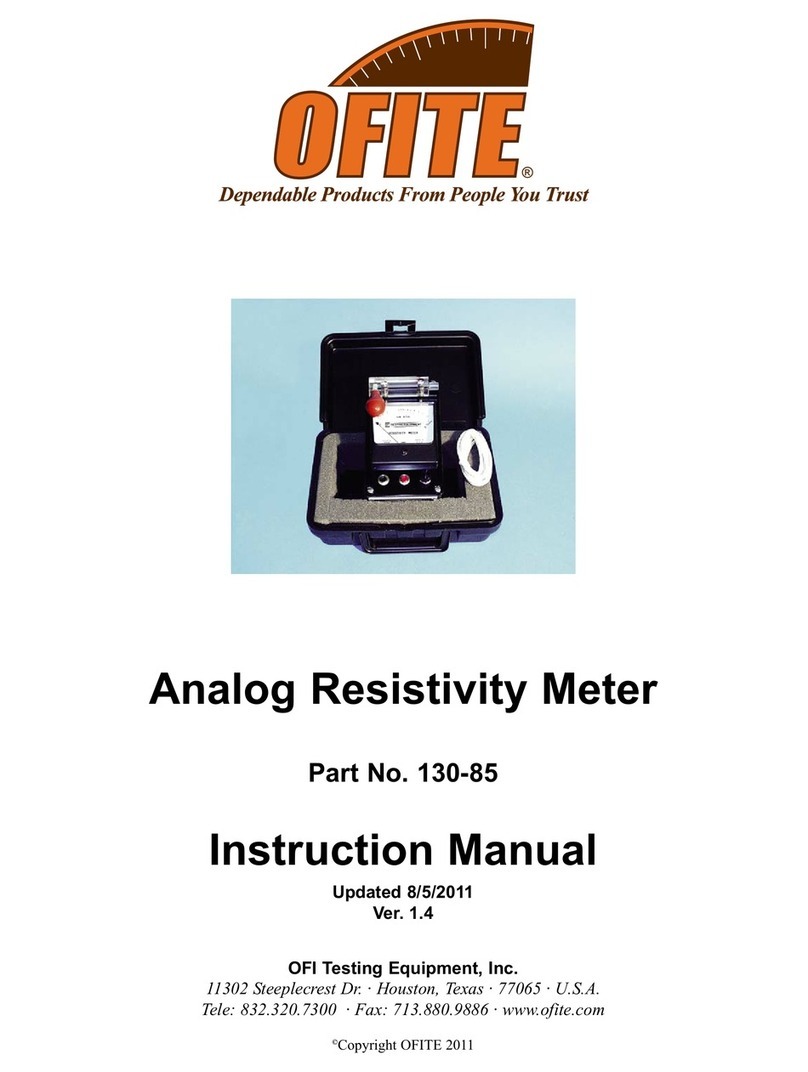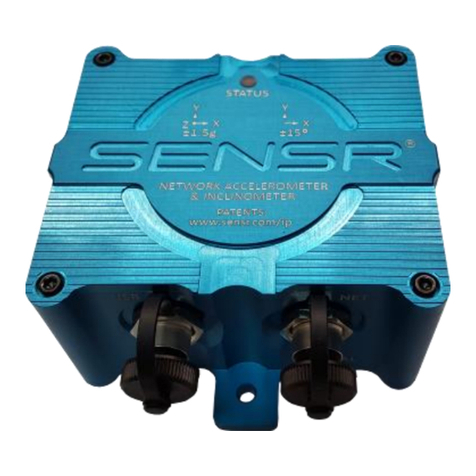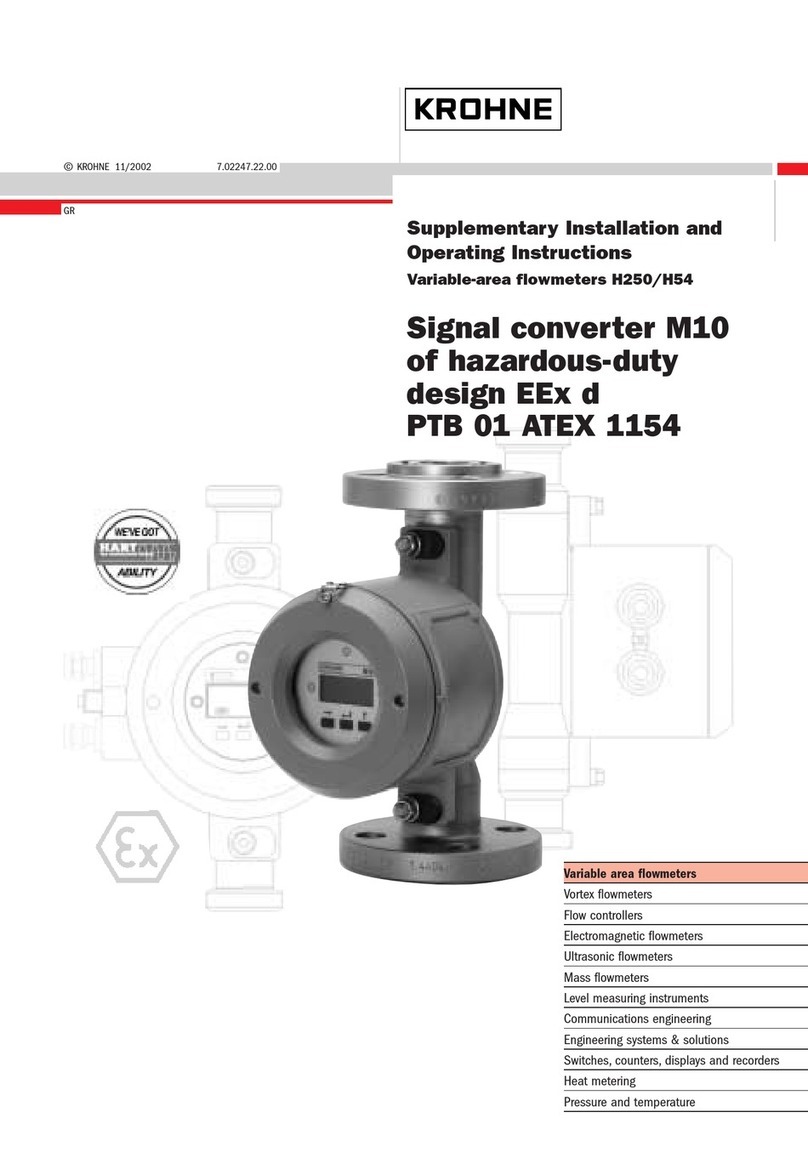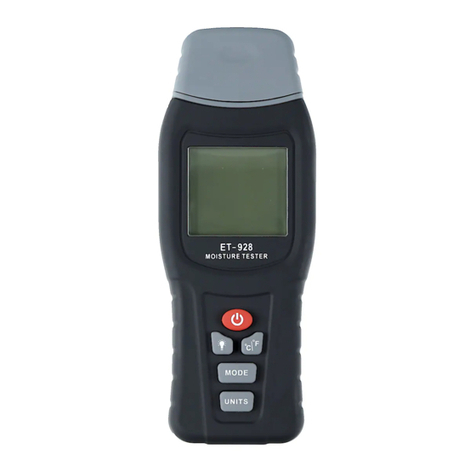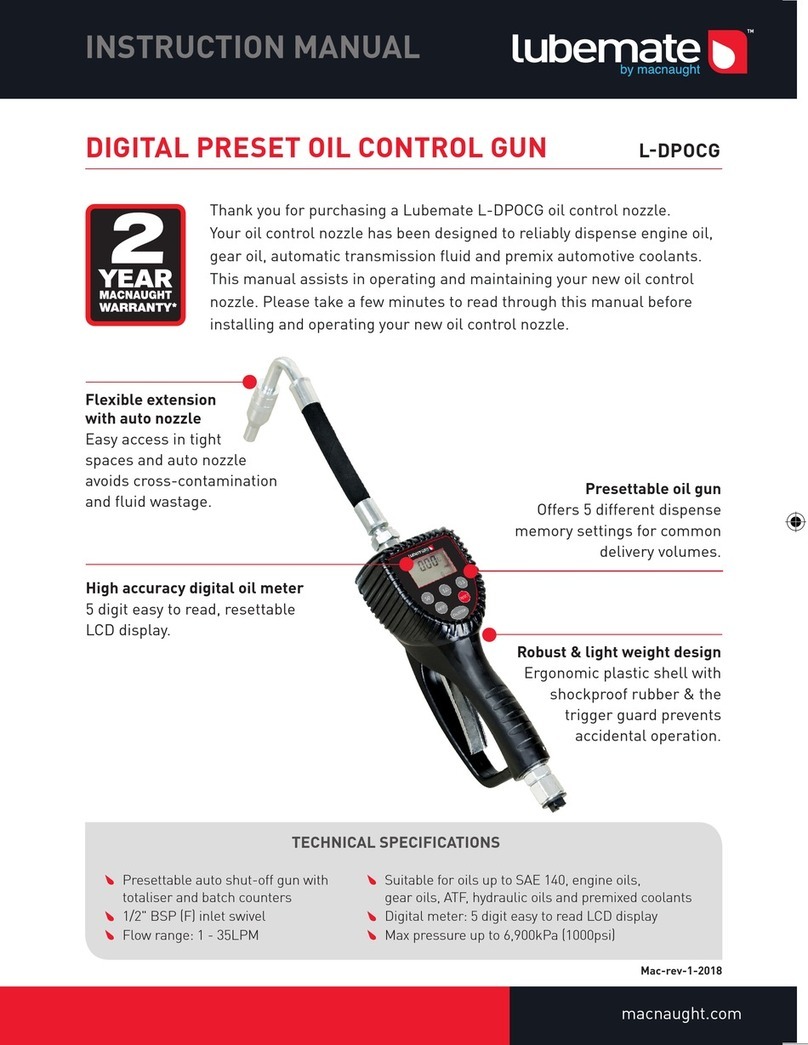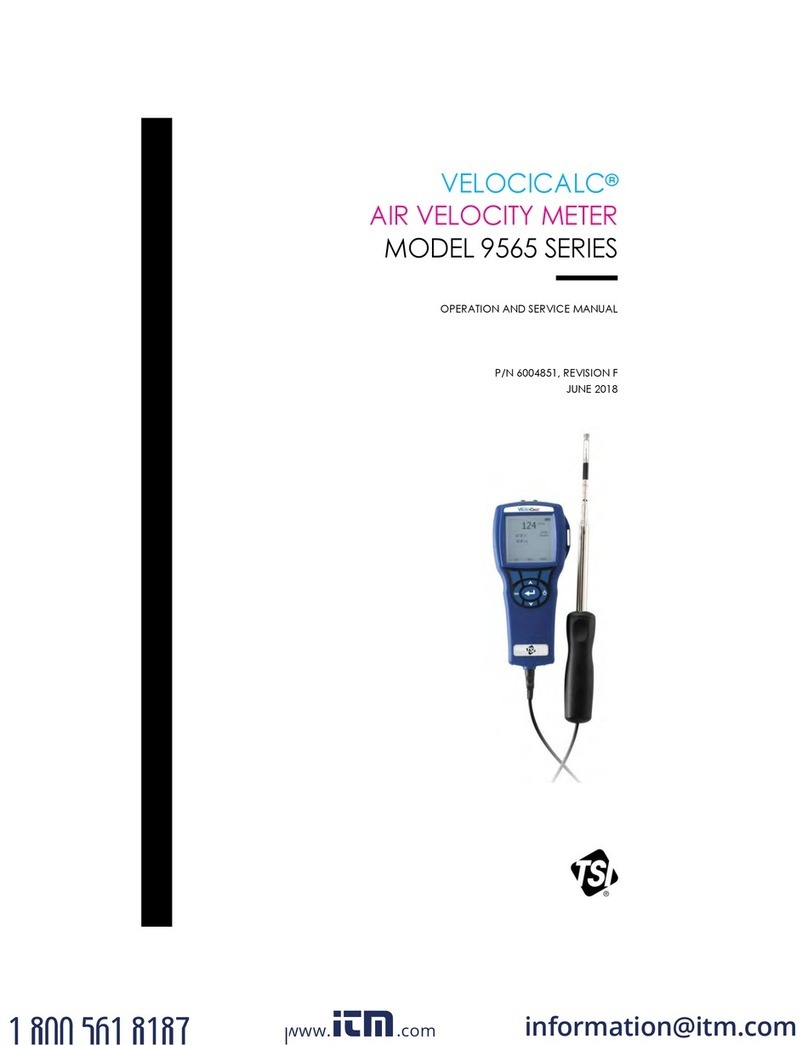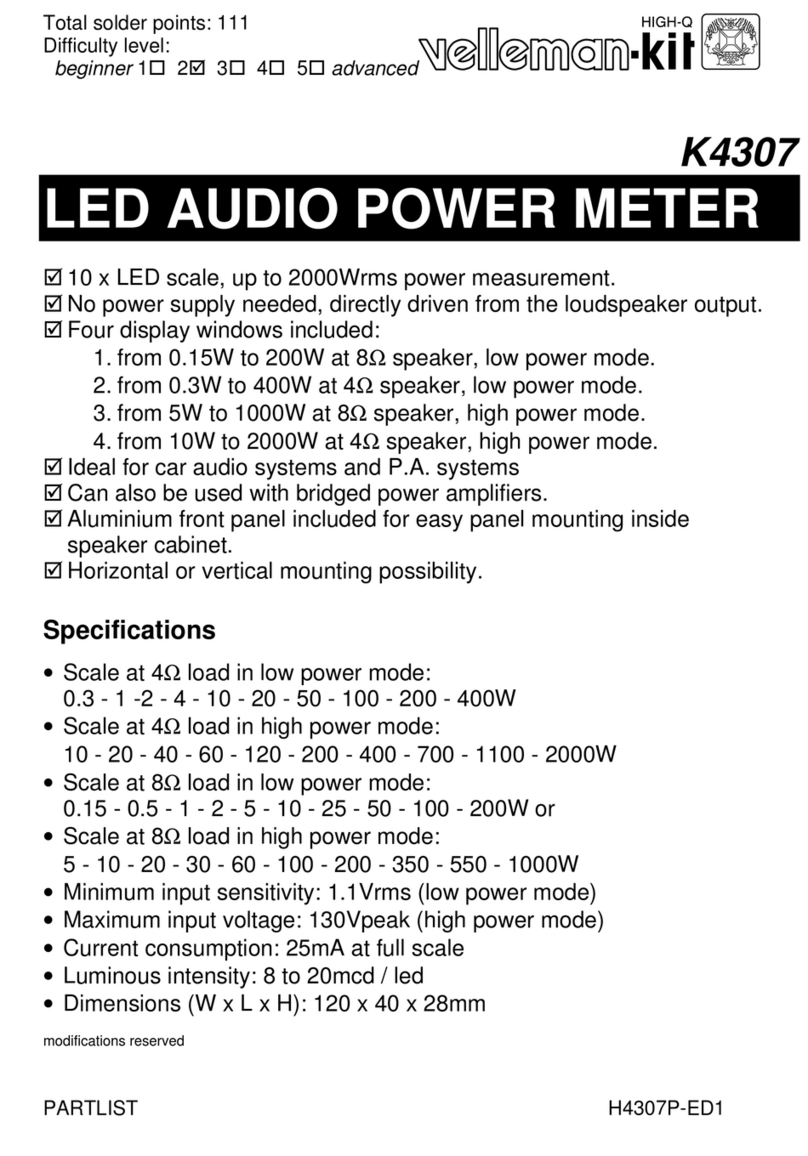ROCTEST TEXAM User manual

TEXAMePRESSUREMETER
INSTRUCTION MANUAL
Roctest Limited, 2017. All rights reserved.
This product should be installed and operated only by qualified personnel. Its misuse is potentially dangerous. The Company makes no warranty as to the information furnished
in this manual and assumes no liability for damages resulting from the installation or use of this product. The information herein is subject to change without notification.
Tel. : 1.450.465.1113 • 1.877.ROCTEST (USA, Canada) • 33 (1) 64.06.40.80 (Europe) • www.roctest.com • www.telemac.com
E1001A-171107

E1001A-171107
1
TABLE OF CONTENTS
1DEFINITION AND PURPOSE OF TEST...................................................................2
2EQUIPMENT DESCRIPTION ...................................................................................3
3EQUIPMENT ASSEMBLY........................................................................................5
4USING THE DP BOX................................................................................................6
4.1 Description.........................................................................................................6
4.2 Installing the DP BOX READER APPS ..............................................................7
4.3 Connecting and turning on the DP BOX.............................................................7
4.4 Using the DP BOX READER APPS ...................................................................8
4.4.1 Main Menu..................................................................................................8
4.4.2 Using the DP BOX READER APPS with the TEXAMe.................................9
5SATURATING THE EQUIPMENT ..........................................................................13
5.1 Saturating the control box cylinder ...................................................................13
5.2 Saturation check ..............................................................................................15
5.3 Saturating the tubing probe assembly..............................................................16
6CALIBRATION .......................................................................................................16
6.1 Calibration for pressure correction ...................................................................16
6.2 Calibration for volume correction......................................................................17
7TEST EXECUTION.................................................................................................17
7.1 Making of the borehole.....................................................................................17
7.2Initial readings..................................................................................................17
7.3 Strain controlled test ........................................................................................18
7.4 Stress controlled test........................................................................................19
8PROBE DISASSEMBLY AND ASSEMBLY ...........................................................19
9TRANSPORT..........................................................................................................22
10 LIMITATIONS OF USE .......................................................................................22
10.1 Cold temperature .............................................................................................22
10.2 Soft material.....................................................................................................22
10.3 Rock.................................................................................................................23
10.4 Dry borehole ....................................................................................................23
10.5 Deep borehole .................................................................................................23
11 RECOMMENDATIONS .......................................................................................23
12 MAINTENANCE..................................................................................................23
12.1 Preventing the equipment from rusting.............................................................23
12.2 Cleaning the filter.............................................................................................24
12.3 Splicing the Tecalan tubing..............................................................................24
13 DATA REDUCTION ............................................................................................24
14 MISCELLANEOUS..............................................................................................27

E1001A-171107
2
1 DEFINITION AND PURPOSE OF TEST
The pressuremeter test is a load test carried out in-situ in a borehole. An inflatable
cylindrical probe is set at testing depth in a pre-drilled borehole within a soil or rock mass
or by direct driving into the mass. The method depends on the materials’ characteristics.
The pressuremeter uses a hydraulic control unit to load and to monitor the tested
material’s response. The data collected defines the stress-strain (or volume/pressure)
relationship of soil and rock with depth. The pressuremeter test data is used to determine
the pressuremeter modulus and limit pressure. The pressuremeter modulus is used to
evaluate settlements for specific foundation designs. The limit pressure is used to
calculate the bearing capacity.
The probe is set at the test depth using the method that will produce the least
disturbance to the test material with the tightest hole possible. Once in place, the probe
is submitted to equal increments of increasing volume or pressure, and the pressure-
volume data is plotted.
The graph below shows a typical curve obtained from a pressuremeter test.
The curve can be divided into three parts. The first portion of the curve corresponds to
the probe seating against the borehole wall. The wall disturbance, induced by drilling or
driving the probe into place, has considerable influence on this segment of the curve.
The difference in borehole and probe diameters also affects this segment. The second
segment represents the pseudo-elastic behavior of the tested material. The probe is in
contact with the borehole walls. This segment is rather linear and defines the deformation
modulus of the tested material. In the last segment, the loaded mass enters a plastic
state during which deformation accelerates towards complete failure point i.e. the limit
pressure.

E1001A-171107
3
2 EQUIPMENT DESCRIPTION
The TEXAMepressuremeter utilizes a monocellular hydraulically inflated probe. A
mechanical actuator is used to displace a piston which travels within a cylinder filled with the
inflation fluid. The TEXAMeis comprised of:
a) A control unit, which contains a cylinder, a piston, connectors, sensors, and a valve.
b) An actuator –mechanical jack -, its four support columns and two crank handles
c) An optional volume counter. The white numbers are cubic centimeter, the yellow
numbers are 0.1 cc (cubic centimeter or cm3) and the yellow marks are 0.01 cc.
d) One optional high precision digital gauge mounted on a quick coupler and vent valve
assembly.
e) A 70-mm diameter probe or a 44-mm probe for use in a slotted casing. The probe
consists of a cylindrical metallic body covered with an inflatable rubber sheath
protected or not with metallic strips.
f) The high pressure black tubing, also called Tecalan
g) A steel pipe for calibrating the probe –not included.
h) One Readout Box for Pressure and Volume reading
The TEXAMedesign complies with the ASTM-4719 standard.
MAIN SPECIFICATIONS
Working capacity
10 000 kPa
Modulus range
1 to 2000 MPa approx.
Volume Resolution
0.01 cm3
Volume capacity
1 732 cm3
Pressure resolution
1 kPa
Test Mode
Strain or stress controlled
UNITS
Pressure : 100 kPa = 1 kg/cm2= 1 bar and approximately 1 tsf, 2000 psf, and 15 psi
Length : 1 cm = 0.3937 inch

E1001A-171107
4
TEXAM Control Unit
a
Large handle
b
Screw jack (actuator)
c
Hexagonal Nut (4)
d
Washer (4)
e
Knurled Nut
f
8-32 Flat Head Screw (4)
g
Volume Counter (optional)
h
Handle
i
Support Column (4)
j
Control Box
Please see the appendix for additional components descriptions.
a
b
c
d
e
f
g
h
i
j

E1001A-171107
5
3 EQUIPMENT ASSEMBLY
1. The control unit comes in two separate boxes, one containing the actuator and the other
containing the cylinder, piston and front plate. Remove the cover from the control unit
case.
2. Screw in the 4 actuator support columns (i). The knurled portion of the columns points
downward and the columns are hand tightened.
3. Remove the threaded PVC protective caps from the piston shaft and from the knurled
nut (e)
4. Install the mechanical actuator (b) on its support columns. Make sure that the 4 washers
(d) have been removed from the columns. Position the actuator so that the crank shaft
is to the right of the control unit and perpendicular to the case handles. Put the 4
washers (d) and 4 nuts (c) in place. Do not tighten the nuts yet.
5. Connect the DP Box to port number 5. Make sure volume and pressure transducers
read properly. Refer to section below on how to use the DP Box. Note that volume
readings obtained from the electrical sensor must prevail over the one displayed by the
mechanical volume counter. See section 13 for more details.
6. Place the small crank handle (h) on the crank shaft of the actuator. Turn the handle
counter clockwise to bring the actuator screw in contact with the piston shaft. Couple
the actuator screw with the piston shaft by threading the knurled nut (e) onto the male
thread of the piston shaft. Hand tighten the knurled nut. The volume should read close
to 0 cc.
7. Tighten the nuts (c) with a wrench.
8. If available, connect the optional digital gauge kit on the port number 3 and turn it on.
Read the gauge operating procedures at the end of this manual to adjust the desired
engineering units to perform the test –we recommend in kPa. Open the valve mounted
on the assembly to vent the gauge, reset the zero, and then close the vent valve.

E1001A-171107
6
4 USING THE DP BOX
4.1 DESCRIPTION
DP BOX communicating with a tablet by Bluetooth
The DP BOX is designed for reading and logging measurements obtained from
pressuremeters and dilatometers manufactured by Roctest (including models DMP 95,
TEXAMEand PROBEX). Thanks to the Bluetooth communication feature and to the DP
Box READER Application, the DP Box can be used in conjunction with a Tablet for
reading the sensors, for configuring a calibration or a testing session, for visualizing and
logging the test results in real time, and for reviewing any test data. These test data can
be uploaded to a laptop via USB communication. The DP Box comes in a convenient
water proof enclosure and is fitted with two 12-V rechargeable batteries providing over 8
hours of autonomy in normal conditions. The DP Box also comes with cable universal AC
wall plug with US/Euro adapter + adapter cable for car (lighter) and for external battery.
The battery can be charged every night. A charging circuit inside the readout limits
charge time to a certain level.
The front panel is splash proof allowing the use the equipment in wet conditions.
However do not let the readout with the cover lifted up under the rain over extended
period of time, otherwise water could get into the unit.
The DP Box is compatible with Android-based tablet model.

E1001A-171107
7
DP BOX Front Panel
A
4-pin Cannon connector for charging the DP Box batteries
B
LED indicating communication status: blinking slowly when the Bluetooth radio
waits for a connection, then glowing faster when the connection is established.
C
Switch for turning ON / OFF the unit
D
USB port for charging the Tablet (if necessary)
E
10-pin connector for connecting the dilatometer / pressuremeter
4.2 INSTALLING THE DP BOX READER APPS
Prior from using the DP Box, the DP Box READER Application should be installed on a
Tablet. This application can be downloaded from Roctest web site.
4.3 CONNECTING AND TURNING ON THE DP BOX
Connect the electrical cable of the testing equipment to the DP Box.
Turn on the DP Box. The LED on the front panel will then blink. Turn on the Tablet. Go in
the Tablet Setup and make sure that the DP Box is available and paired with the Tablet.
Set up the Tablet as follows:
Adjust the Display in ‘Outdoor Mode’ if necessary. But note that this will reduce
the Tablet autonomy.
Adjust the screen timeout (typically 5 min)
Make sure Tablet is adjusted for dot-delimited numbers
Make sure the battery voltage of the tablet is high enough for use.
A
B
C
D
E

E1001A-171107
8
Open the DP Box Application and go in ‘Settings / Quick Reading’ for establishing
Bluetooth communication between the DP Box and the Tablet, which will be confirmed
when the DP box LED will blink quicker (see below for more information).
4.4 USING THE DP BOX READER APPS
The DP Box Application allows configuring the unit, to read and to log the data, and to
review the results.
4.4.1 MAIN MENU
Main menu of the applications includes the following elements:

E1001A-171107
9
DP Box Application Main Menu
4.4.2 USING THE DP BOX READER APPS WITH THE TEXAME
First Go to ‘Settings’. The APPS will automatically scan for establishing Bluetooth
communication with the DP BOX which takes a few seconds. The name of the DP Box
will then replace the ‘Scanning’ inscription.
Used for configuring and
running a testing session
Used for configuring and
running a calibration
session
Used for viewing readings
Used for:
Establishing Bluetooth
communication
Selecting an Instrument
Type (TEXAM, DMP,
PROBEX)
Selecting the units
Setting Date and Time
And for Quick Readings of
the Sensors

E1001A-171107
10
Go to ‘Instrument / Add a New Instrument’and Select the ‘Type of instrument’(TEXAM)
and enter the serial number appearing on the control unit (e.g. 001A17003).
The DP Box name should
appear here
Select for additional
functions (Editing,
deleting instruments…)

E1001A-171107
11
Make sure the conversion factors associated to this instrument have been entered. Refer
to the calibration certificate. For changing these, select ‘Calibration / Cal. Type / Review
Factory Calibration’ and select ‘Change factory calibration’, make the appropriate
changes and select ‘Save new factory calibration’ at the bottom of the screen.
Set the units (typically ISO), then set the date and time of the Tablet if necessary.
Go in ‘Quick Readings’and press the green icon for reading the sensors.
Two types of calibrations can be done, one with the probe unconfined (‘Pressure Loss
Calibration’) and one with the probe confined (‘Volume Loss Calibration’). See next
section for more details.
For configuring a calibration, go to ‘Calibration’ and :
Select the type of calibration
Select a probe (by giving a serial number –generally indicated on the probe itself
–and by selecting ‘Texam NL Vulcolan rings, NL steel rings A probe or slotted
casing’probe)
Dive a calibration ID
Set the calibration timer
For configuring a test, go to ‘Test’ and proceed the same way.

E1001A-171107
12
Typical set up:
ID 1
Timer Typical (sec)
Pressure loss
calibration
‘CAP+Date’
30
Volume loss calibration
‘CAV+Date’
60
Test
‘TE+Date’
15
1The Apps will automatically increment selected ID
Once setup is completed, select: ‘Begin Calibration or Test’ to start.
Once calibration or testing is started, a window like the one below will be displayed.
After saving the initial readings, the operator should press ‘Start’ for starting the timer.
Readings will be recorded when timer gets to 0 second. Then the operator can increase
the volume or pressure to the first step and then press ‘Start’ for starting the timer, and
so on until completing the test.
When the calibration or test is over, press on :
For starting the timer.
Readings are
automatically recorded
each time timer gets to
zero
Graph is plotted here
Displays actual Pressure
and Volume readings
For stopping the
calibration/test
Displays last three
Volume and Pressure
Readings recorded

E1001A-171107
13
For reviewing results, go to ‘Data Files’, the select ‘Calibration’ or ‘Field Test’. Then
select the specific file you want to see.
5 SATURATING THE EQUIPMENT
5.1 SATURATING THE CONTROL BOX CYLINDER
1. Connect the short length of flexible tubing to the "Fill" quick connect port No. 4. Push on
the connector until you hear a ‘click’.
2. Place the free ends of the saturation tubings in a small container –we suggest a 1
gallon plastic bottle - of clean water or antifreeze solution. It is imperative to maintain
the ends of the tubings submerged during the saturation. Otherwise, air will enter the
TEXAMe. You may tape the tubings to the bottle for ensuring that.
3. Set valve No. 6 on "FILL".
4. Turn the small crank handle clockwise to bring the cylinder piston to its uppermost
position corresponding to about 1732 cc on the counter. The uppermost position is
reached when resistance is felt when cranking. Stop cranking then for not damaging the
equipment. While the piston is rising, the air in the cylinder is coming out from the tubing
connected to the port No. 4. Bubbles should be observed in the bottle.
Select for viewing info
about the calibration /
test
Select for viewing data

E1001A-171107
14
5. Lower the piston by turning the crank handle counter-clockwise at a rate of
approximately 1 rotation per second. While the piston is lowering, water is pumped
inside the cylinder via the tubing connected to the port No. 4.
6. When the piston has traveled to its lowermost position corresponding to 0 cc, stop the
cranking operation and wait a few seconds for the suction to stop, as indicated by a 0-
kPa reading.
7. Set valve No. 6 on "TEST".
8. Connect the short length of flexible tubing to the "Probe" quick connect port No. 1
9. Incline about 45 degrees the control unit toward yourself when facing the control unit.
Turn the crank about 20 revolutions (240 cc) clockwise to expel any air that may have
accumulated at the top of the cylinder. During this operation, watch closely to see that
all entrapped air is evacuated and only bubble free water is flowing into the bottle by the
tubing connected on the port No. 1.
10. Return the instrument to the vertical and disconnect tubing from the port No. 1.
11. Connect the hose to port No. 3.
12. Turn the crank until water comes out from the short tubing to expel the air trapped in the
gauge line. Disconnect the hose from port no. 3.
13. When using the optional digital gauge kit, proceed the same way. But make sure to
open the valve mounted on the pressure gauge assembly before cranking and to close
it after cranking.
14. Set valve No. 6 on "FILL".
15. Bring the piston to 0 cc, by turning the crank handle counter clockwise. When fully
lowered, wait a few seconds and perform the saturation check.
TEXAM Facia

E1001A-171107
15
Hydraulic Circuit Schematic Diagram
5.2 SATURATION CHECK
1. Set valve No. 6 on "TEST".
2. The volume and pressure should indicate around zero.
3. Install the large crank handle (a) on the rear side of the actuator and pressurize the unit
up to 2,500 kPa by rotating the large crank handle clockwise. Read the volume.
If the volume indicated on the readout is more than 15 cc, the instrument is not
completely saturated. Repeat the saturation procedure described in steps 4.1.7 to
step 4.1.15.
The instrument is completely saturated when the volume indicates less than 15 cc at
2,500 kPa. Having determined that the instrument is completely saturated, rotate the
large crank handle until the pressure reaches 10,000 kPa.
The pressure should stabilize after 2 minutes between 10,000 kPa and 9,500 kPa if
there is no leak in the system.
Bring the pressure back to 0 kPa by returning the piston to its lowermost position.
Valve # 6

E1001A-171107
16
5.3 SATURATING THE TUBING PROBE ASSEMBLY
1. Connect the extremity of the Tecalan tubing fitted with the quick connect to port No. 1.
Thread the other end of the tubing through the probe to rod adaptor and connect it to
the probe. Tighten the nut using two wrenches. Do not over tighten: the brass nut is
fragile and may crack. Lay down the probe next to the control box.
2. Remove the plug located at the lower extremity of the probe. Hold the probe bottom
end up slightly inclined and with the saturation outlet in the 12 o'clock position.
3. With the valve No. 6 on "TEST", inject water into the probe by rotating the crank handle
clockwise until bubble free water only is flowing out of the saturation outlet of the probe.
Stop turning the crank handle. Put the plug in place and tighten.
4. Put the probe in the calibration tube. Inject fluid in the probe and pressurize it up to
8,000 kPa. Hold pressure for three minutes and check for leaks around the probe. Start
deflating the probe. Remove the probe from calibration pipe as soon as possible. Keep
on deflating the probe until it looks deflated (uniform diameter). Do not deflate it too fast
–see warning in following section. Do not deflate it too much, otherwise gaps between
the metal fins on the probe will open. These must remain closed as much as possible.
5. Disconnect the Tecalan tubing from port No. 1. Refill the cylinder by placing valve No. 6
on "FILL" and returning the piston to its lowermost position. Wait a few seconds.
6. Repeat step 4.2 as a final check on the saturation of the unit.
7. Disconnect the tubing from port No. 4.
8. The instrument is ready to be calibrated. The instrument, probe and tubing can be
saturated in advance and transported to the site ready for testing.
6 CALIBRATION
6.1 CALIBRATION FOR PRESSURE CORRECTION
This calibration must be done each time a new sheath is put on the probe. It allows to
measure sheath resistance. Typically it ranges from 30 to 100 kPa at 1600 cc for an N-
size probe.
1. The probe is placed at ground level and is unconfined.
2. Connect the Tecalan tubing to port No. 1.
3. Place valve No. 6 on "TEST".
4. Rotate the small crank handle clockwise at a rate of 1 revolution every 2 seconds, until
80 cc have been injected (long 70 mm probe) or 40 cc (44 mm probe).
5. Stop the injection, wait 30 seconds and record the pressure and the volume.
6. Continue this procedure until 1440 cc are injected for 70 mm probe or 760 cc for 44 mm
probe.
7. Slowly rotate the crank handle counter clockwise to return the piston to its initial position.
8. Check the curve of injected volume versus pressure.
Warning: Deflation of the probe must always be done slowly (less than 1 revolution
every 2 seconds) to prevent air infiltration in the pressuremeter. Negative pressure
should not go under - 50 kPa. Once in a while, stop cranking and wait for the
pressure to come back close to 0 kPa before resuming cranking.

E1001A-171107
17
6.2 CALIBRATION FOR VOLUME CORRECTION
This calibration must be done each time after assembling a membrane and saturating the
system. IT IS SUGGESTED TO REPEAT THIS CALIBRATION EVERY DAY OF USE
OF THE PRESSUREMETER TO ENSURE THAT 1) THERE IS NO LEAK, 2) THAT AIR
DID NOT INFILTRATE THE PRESSUREMETER, AND 3) THAT SYSTEM EXPANSION
HAS NOT CHANGED SIGNIFICANTLY. This procedure allows determining the system
expansion in order to calculate the net cavity volume change. The system expansion
comes from tubing expansion, membrane squeezing and from the compression of the
small quantity of air in the fluid. Typically it ranges from 0.006 to 0.016 cm3/ kPa,
depending on the Tecalan’s length.
When a special test is to be performed (cyclic test, creep consolidation test, stress level
influence test…) with a special loading sequence, then a special calibration performed by
following a similar loading sequence is suggested.
1. Connect the Tecalan tubing to port No. 1.
2. Place valve No. 6 on "TEST".
3. Place the probe inside a rigid steel pipe: NW or AW drill casing or equivalent for the 70
and 44 mm diameter probes respectively.
4. Rotating the crank handle clockwise until reaching 500 kPa. Start chronometer. Maintain
pressure around 500 kPa by slightly rotating crank handle if necessary. Stop cranking at
least 5 seconds prior to recording readings. Record volume and pressure after 60
seconds.
5. Install the large crank handle.
6. Increase pressure by another 500-kPa step and take readings after 60 seconds as
described above. Repeat this procedure to 6,000 kPa.
7. When tests in very hard material are to be done –where it is expected to exceed 6,000
kPa during the test - follow the same calibration procedure but using 1,000 kPa
pressure steps up to 10,000 kPa
8. Return the piston to its lowermost position to decrease the pressure and volume close
to 0.
Warning: Deflation of the probe must be done slowly –see warning at section 5.1
7 TEST EXECUTION
7.1 MAKING OF THE BOREHOLE
The preparation of a quality borehole is essential for obtaining a satisfactory test. The
two most important things are 1) to make a borehole with a proper diameter (between
1.03 and 1.15 x diameter of the probe); 2) to cause the least disturbance possible to the
borehole wall. Various methods can be used depending on the type of soil and available
equipment. Rotary drilling with axial injection of prepared mud is the most versatile
method and is recommended for most cases. Methods using injection of fluids are
especially suited for the TEXAM since this pressuremeter requires fluid in deep
boreholes (deeper than 10 m) for deflating the probe.
7.2 INITIAL READINGS
1. De-airing the unit. Just before the test, disconnect the Tecalan tubing from the
control box, put the saturation hose in a bottle filled with water or anti-freeze, and de-

E1001A-171107
18
air the unit following steps 4.1.7 to 4.1.15 described above. Then proceed to a
saturation check to make sure that less than 15 cc are required for increasing
pressure up to 2500 kPa. Bring pressure and volume down to 0 and disconnect
saturation hoses.
2. Initial readings. Reconnect the Tecalan-probe assembly to the control box. Just
before lowering the probe in the borehole, write down the initial Pressure and Volume
readings. Make sure that the probe is at the same height then the gauge of the
pressuremeter. Normally these initial readings should be close to 0, however
sometimes due to temperature effects or other effects they are not. These initial
reading should be subtracted to the raw test data afterwards.
3. Once the probe is lowered in place, pressure reading may be different than zero. Do
not re-zero the pressure. Start the test.
7.3 STRAIN CONTROLLED TEST
The strain controlled test is the recommended method for general applications.
1. With the probe set at the test depth, the pressuremeter test can begin. The test is
carried out in 40 steps of equal volume increments. The volume increments are about
40 cc for the long 70 mm diameter probe and about 20 cc for the 44 mm diameter
probe. Rotate the crank handle clockwise at a uniform rate of about 1 rotation per 4
seconds to inject water, stopping to record the pressure 15 seconds after each step of
volume. The maximum volume injected is 1600 cc for long 70 mm probe and 800 cc
for 44 mm probe; this is equivalent to 40 increments.
2. Stop the test : a) when a sufficient number of data have been collected for the intended
purpose of the tests, typically for determining the limit pressure with a satisfactory
accuracy (typically between 1000 to 1200 cc for an NL probe) ; b) or when risk of
bursting the probe is high –see chart at the end of this manual.
3. It is possible and suggested to carry on an unload-reload cycle in the pseudo-elastic
zone i.e. between Pf (creep pressure) and Po (in-situ horizontal earth pressure). This
cycle can be performed different ways. The ASTM-D4719 standard suggests running
this cycle in one step down to Pf / 2, and then back the same way up to Pf. Another
method consists in reducing pressure in three equal-pressure steps down to a point
slightly above Po, and then back the same way up to Pf. Roctest recommends using
the latter method.
During a test the end of the pseudo-elastic zone may be found by keeping track of p,
which will start decreasing when the soil starts to yield. When the unload-reload cycle is
completed, the test is resumed in the plastic zone as a normal test.
4. When the test is over, slowly return the piston to its initial position.
Warning: Deflation of the probe must be done slowly –see warning at section 5.1.
Make sure that the borehole is filled with fluid for helping deflating the probe.
Warning: If the pressure drops to zero or close to zero, this means that the sheath is
punctured. Do not bring volume back to 0 cc. Dirty water or mud would get into the
unit.
5. Withdraw the probe. If this can’t be done because the probe is sticking to stiff plastic
clay or because of caving problem, follow this procedure: the probe is pulled up about 5
mm and pushed back by two persons with pipe wrenches on the rods. This is repeated
until this up and down cycling process weakens the soil and frees the probe. It is also
possible to apply some vegetable oil on the probe’s membrane to prevent it from
sticking to clayey soils.

E1001A-171107
19
6. After retrieving the probe, clean the probe (outside and inside) using a nylon brush and
a bucket filled with water.
NOTE : The loading sequence suggested in the ASTM-4719 Standard differs from the
sequence described above. According to the TEXAM developer and manufacturer,
the method described in this manual yields equivalent results –within normal
accuracy range of the PMT testing in general - while being easier to follow and
slightly more accurate.
7.4 STRESS CONTROLLED TEST
This method is used during a creep test (see below). It can also be used for tests in very
hard soils or in soft rock.
1. Lower the probe to the test depth.
2. Place valve No. 6 on "TEST".
3. Crank until reaching the first pressure step corresponding to about 1/10 of the estimated
limit pressure.
4. Maintain the pressure at this value and record the counter readings 30 seconds, and 60
seconds after the pressure step has been reached. Always stop cranking at least 5
seconds before recording data.
5. When the test is over, slowly return the piston to initial position.
Additional comments:
Pressure step is generally 0.25, 0.5, 1 or 2 bars in soils, and 5 bars in rock. Pressure
step can be estimated with the following relation: Pressure step (bar) = N (blow per
foot) /20. Example if N = 17, start with a 0.5-bar pressure increment.
Check delta V 60 sec –30 sec (cc) at each step in order to determine if you are in
the pseudo-elastic zone or in the yielding zone. The first zone is characterized by
rather constant delta V. The second zone is characterized by increasing delta V. If
you still are in the pseudo-elastic zone after 7 steps, double pressure increment.
Adjust pressure steps to try to get 7-14 steps total in the test with at least 2-3 steps
in the yielding zone.
An unload-reload cycle can be done. See instructions above.
Warning: Deflation of the probe must be done slowly –see warning at section 5.1.
Make sure that the borehole is filled with fluid for helping deflating the probe.
8 PROBE DISASSEMBLY AND ASSEMBLY
DISASSEMBLY :
1- Screw the probe vise adaptor onto one end of the probe and clamp the adaptor in
the jaws of a 4-inch bench vice.
2- Use a strap wrench to unscrew the knurled nut from the free extremity of the
probe.
3- To extract Vulcolan tapered rings, use the extractor provided with the instrument.
Insert and screw in the extractor pins into the two diametrically opposite holes
located on the metal collar of the Vulcolan ring. Rotate the extractor in the
direction of lamination of the metal strips and simultaneously pull the extractor
Table of contents
Other ROCTEST Measuring Instrument manuals
